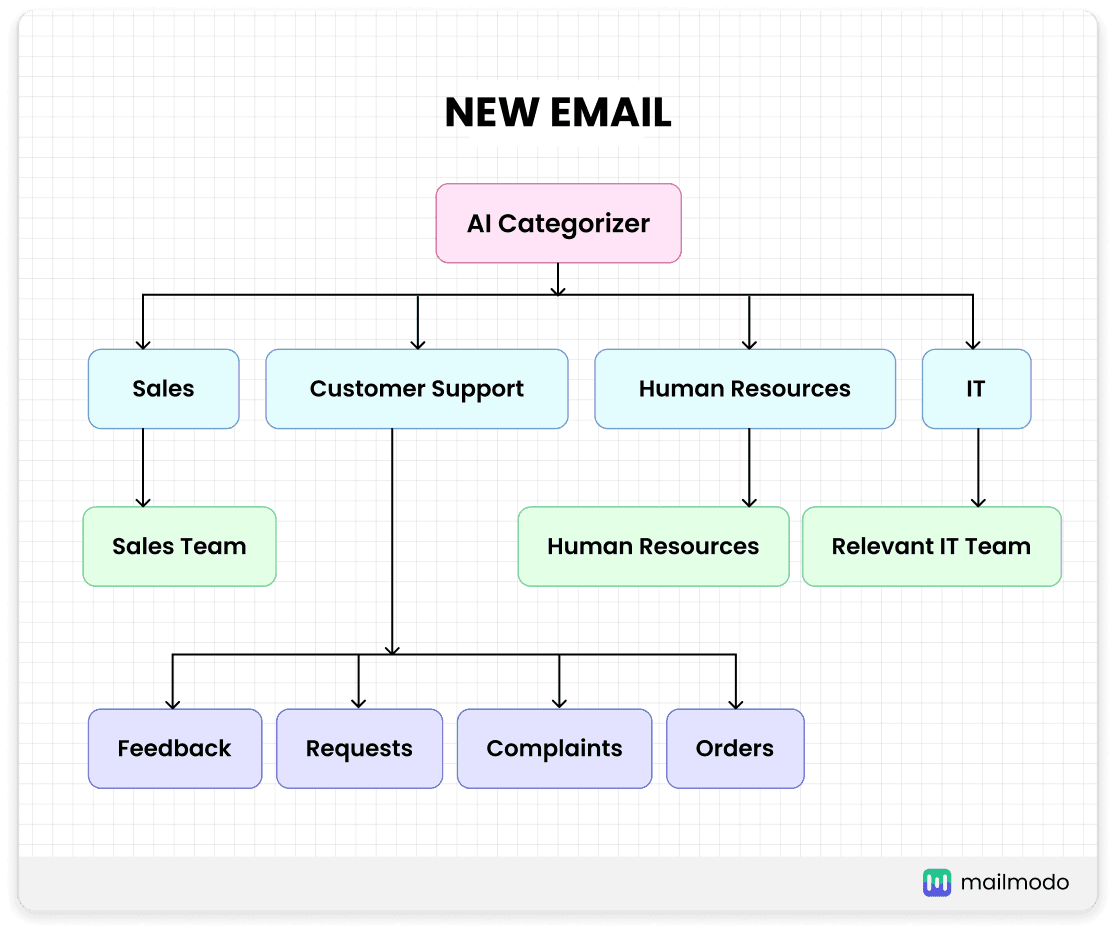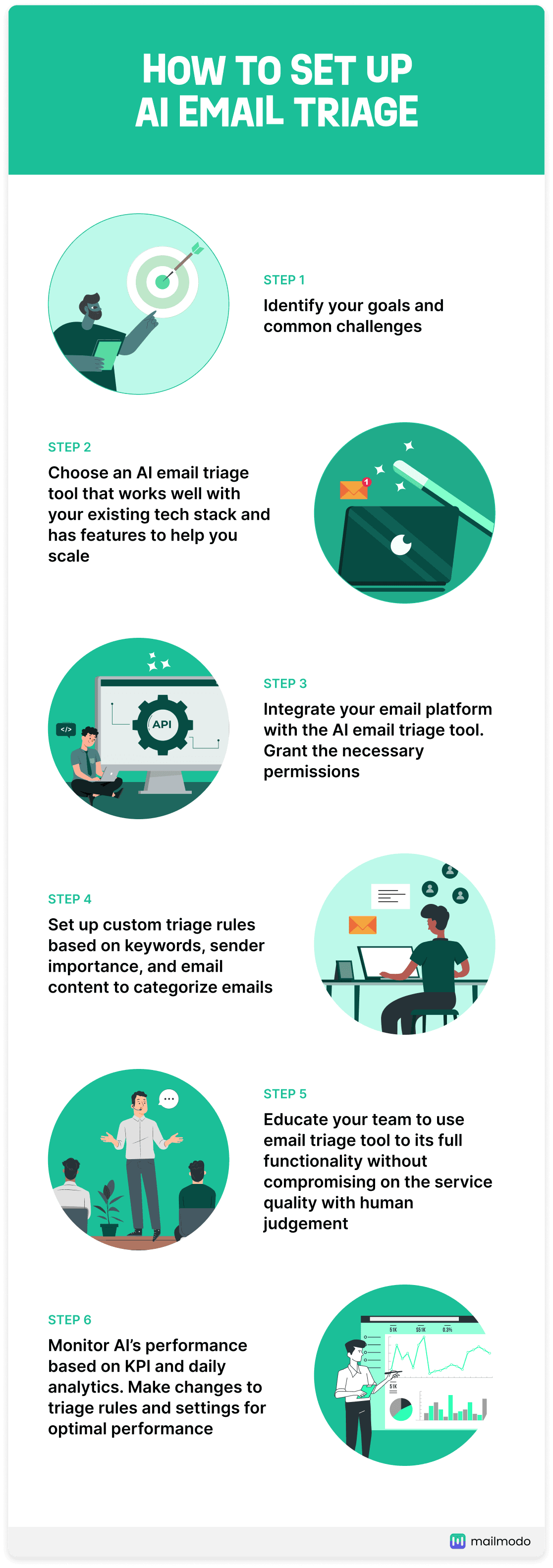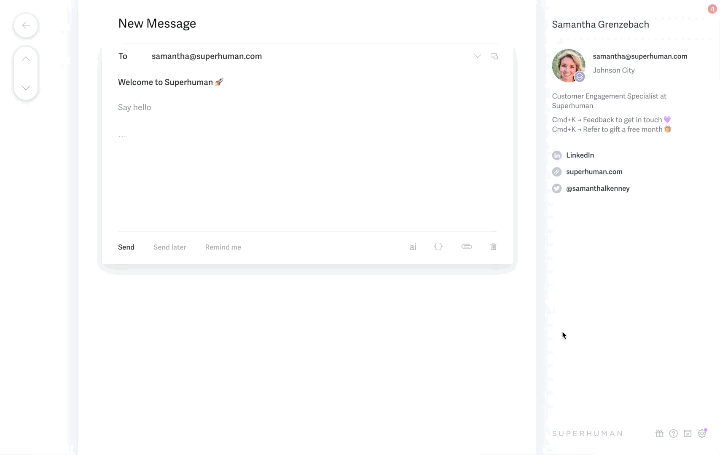What is AI email triage?
AI email triage is an advanced email management approach that uses AI algorithms to categorize and prioritize incoming emails. Unlike traditional email management methods that rely on manual sorting and filtering, AI email triage automates the process by learning from historical data and user behavior and training AI models to do the same.
If you've just come to know about inbox management, you must also learn about the concept of Inbox Zero. Inbox Zero is an email management strategy coined by productivity guru Merlin Mann to keep your inbox clutter-free.
According to Inbox Zero, you must take immediate action on the emails as they land in your inbox by responding, deleting, delegating or archiving them in a separate folder for later. The goal is to minimize the time and mental energy spent managing emails, reduce stress, boost productivity, and ensure essential messages don't get missed.
💡 Related guide: How to Manage Your Emails with Inbox Zero
How does AI email triage work?
AI email triage employs sophisticated machine learning models that analyze aspects like the sender, subject line, and email content to identify urgent and important messages while detecting spam or low-priority emails. It continuously learns and adapts, enhancing accuracy.
It also streamlines communication by providing tailored response options. By categorizing emails based on topics, urgency, and action items through content analysis, email triage acts as an AI-powered assistant, helping you take control of your inbox for enhanced productivity.
Why do you need AI email triage?
The exponential growth of email communication has made it increasingly difficult for businesses to manage their inboxes effectively. Customer service teams, in particular, often struggle with high volumes of incoming communications, leading to delayed responses and customer frustration.
Moreover, manually sorting through emails can significantly impact employee productivity. A recent Microsoft study found that the average professional spends 15% of their workday reading and responding to official communications.
By adopting AI triage solutions, businesses can reduce the time spent on email management. It allows employees to focus on more value-added tasks and spend less time sifting through their inboxes, ultimately reducing inefficiencies in their workflow.
It also enables faster response times to critical customer inquiries, as urgent messages are automatically prioritized and routed to the appropriate teams. This improved efficiency can directly translate into higher customer satisfaction (CSAT) scores, reduced average resolution times (ART) and average handle time (AHT), and a competitive edge in the market.
AI email triage tools offer several key features to address the challenges of communication overload and improve response times for critical emails. Let’s take a look at them one by one.
Automatic email classification and prioritization

One of the primary functions of AI email triage tools is automatically classifying and prioritizing incoming emails based on predefined criteria. These tools can analyze various factors, such as:
Sender information: Prioritizing emails from key clients, partners, or high-priority contacts.
Keywords and phrases: Identifying urgent requests, complaints, or time-sensitive matters based on specific keywords in the subject line or email copy.
Sentiment analysis: Detecting the emotional tone to prioritize messages that express frustration, dissatisfaction, or urgency.
Smart reply and automation features
Advanced tools also offer smart reply and automation capabilities. These features leverage natural language processing (NLP) to suggest relevant responses based on the content of the incoming email.
AI email triage tools can automate the entire response process, sending pre-approved replies without manual intervention for common inquiries or frequently asked questions. This automation saves time and ensures consistency in communication and faster resolution of customer issues.
Integration and customization options
Some AI triage tools integrate seamlessly with existing platforms, like Gmail, Outlook, Microsoft Exchange, and others. This integration allows users to leverage the power of artificial intelligence without disrupting their current workflows or requiring them to switch to a new platform.
Furthermore, customization options enable businesses to tailor the AI email triage process to their specific needs and preferences. This may include setting custom prioritization rules, defining particular keywords or categories, and adjusting the automation settings to align with the organization's communication style and tone.
How to implement an AI email triage workflow
Let’s look into a step-by-step journey on how you can implement AI email triage into your existing workflow.

Step 1: Identify your needs
Assess volume: Gauge the daily volume of emails to understand the required scale.
Pinpoint challenges: Identify common challenges such as response delays or misrouted communication.
Check compatibility: Ensure the tool integrates seamlessly with your existing platforms like Gmail or Outlook.
Check features: Look for features like natural language processing (NLP), priority tagging, and response suggestions.
Step 3: Set up and integrate
Install: Set up the tool that you’ve picked by installing it with the help of the installation guide.
Integrate: Ensure the AI email triage tool works harmoniously with CRM systems and other tools for a unified customer view, better service delivery, and a cohesive workflow.
Grant permissions: Grant necessary permissions for the tool to access and manage your emails on your different email accounts.
Step 4: Customize triage rules and workflows
Define rules: Set rules based on keywords, sender importance, and content to categorize and prioritize emails effectively.
Set up advanced features: Set up features such as 'Smart Reply' and 'Sentiment Analysis' to enhance customer interactions.
Step 5: Monitor analytics and optimize
Track key metrics: Monitor improvements in response times, average handling time, and overall productivity to gauge the success of the triage system.
Optimize: Adjust triage settings and rules based on the insights from the performance analytics.

One additional step you must take is to conduct training sessions to educate your employees on the use of AI email triage systems and tools. You must also share with them tips, best practices, or a manual that they can rely on for handling exceptional cases and when it comes to using their human judgement.
With numerous AI email triage tools in the market, selecting the right one for your business can be daunting. To help make an informed decision, we've compared the leading tools in terms of features, ideal industry and pricing.
| AI email triage tool |
Features |
Ideal industry |
Pricing |
| Hiver |
Harvey AI bot for summarizing emails, suggesting templates, and auto-closing conversations |
Ecommerce, finance, marketing and IT operations |
Lite: $15/user/month
Pro: $49/user/month
Elite: $79/user/month
* Harvey AI available in Pro and Elite plans |
| Sedna |
Streamlines communication and integrates with supply chain management systems, automates repetitive tasks |
Maritime, supply chain |
Custom Pricing |
| Help Scout |
AI Summarize for quick context in lengthy email threads, user-friendly interface |
Marketing, SaaS, and education |
Standard: $20/user/month
Plus: $40/user/month
Pro: $65/user/month
* AI Summarize available in Plus and Pro plans |
| Zoho Desk |
Extensive customization, Zia AI for ticket tagging and sentiment analysis |
CRM, SaaS, and software development |
Free: Up to 3 agents
Express: $7/month
Standard: $14/month
Professional: $23/month
Enterprise: $40/month
*Zia available in Enterprise plans only |
| Zendesk |
Intelligent triage with multilingual support, sentiment analysis, and automated routing |
Marketing, technology and SaaS |
Suite Team: $55/agent/month
Suite Growth: $89/agent/month
Suite Professional: $115/agent/month
Suite Enterprise: Custom pricing
Suite Enterprise Plus: Custom pricing
* Advanced AI available at an additional price of $50/agent/month. Available for free in Professional and higher plan levels. |
| Freshdesk |
Freddy AI bot for sentiment analysis, automated email categorization |
Marketing, digital marketing and software development |
Free: Up to 10 agents
Growth: $15/user/month
Pro: $49/user/month
Enterprise: $79/user/month
*Freddy AI bot available in Pro and Enterprise plans |
| Sanebox |
Email sorting into categories like Inbox, SaneLater, based on importance, not requiring server access |
Freelancers, non profit, public administrations, mid size business, and small business |
Snack: $3.49 for 1 email/month
Lunch: $5.99 for 2 emails/month
Dinner: $16.99 for 4 emails/month |
Please note: You must evaluate the tool's ease of use, scalability, and customer support to ensure a smooth implementation and long-term success. Different businesses might have different tools as the right choice depending on their needs, budget, and goals.
Emerging trends in AI email triage
As artificial intelligence technologies advance, we can expect even more sophisticated capabilities in AI email triage tools. Some emerging trends to watch out for include:
Enhanced natural language understanding, enabling more accurate interpretation of email content and intent.
Proactive identification of potential issues and recommendation of preventive actions with predictive analytics.
Integration with other AI-powered tools, such as chatbots and virtual assistants, for seamless customer support across multiple channels.
I’ve long believed that AI won’t just enhance the way we live, but transform it fundamentally. AI is placing tools of unprecedented power, flexibility, and even personalization into everyone’s hands, requiring little more than natural language to operate. They’ll assist us in many parts of our lives, taking on the role of superpowered collaborators.
- Silvio Savarese, Chief Scientist, Salesforce
Case study: Bosch Service Solutions
Bosch Service Solutions, a global provider of customer support services, implemented an AI-powered email triage system to handle the high volume of incoming customer inquiries. The results were impressive:
Reduction in clearing process from over 5 minutes to less than 1 minute per email.
More than 90% of all emails are automatically and correctly pre-classified by text.
Service experts concentrate exclusively on the handling of customer requests.
Email automation increased employee productivity and satisfaction since their tasks involved fewer monotonous and error-prone tasks.
By leveraging AI email triage, Bosch Service Solutions was able to deliver exceptional customer service while optimizing its internal processes, ultimately driving business growth and competitiveness.
Read the full case study here.
Final takeaway
AI email triage allows businesses to tackle the challenges of email overload and enhances their productivity. AI email triage systems enable organizations to deliver faster, more efficient, and personalized customer service by automating the classification, prioritization, and response to incoming emails.
As you embark on your Inbox Zero journey, remember to choose the right tool for your business needs and continuously monitor and optimize your processes. By staying ahead of the curve and embracing the potential of artificial intelligence in email management, you can improve productivity and achieve Inbox Zero simultaneously.













